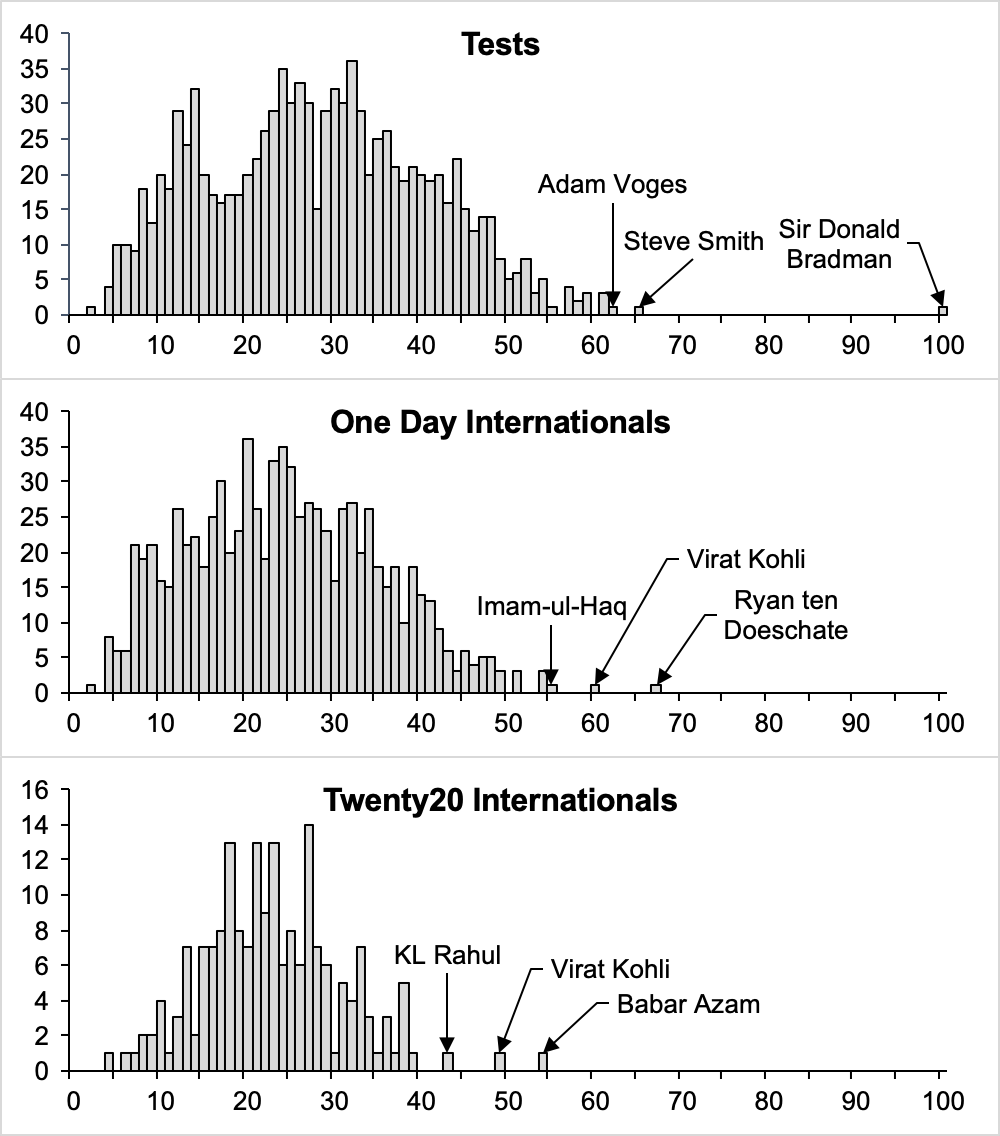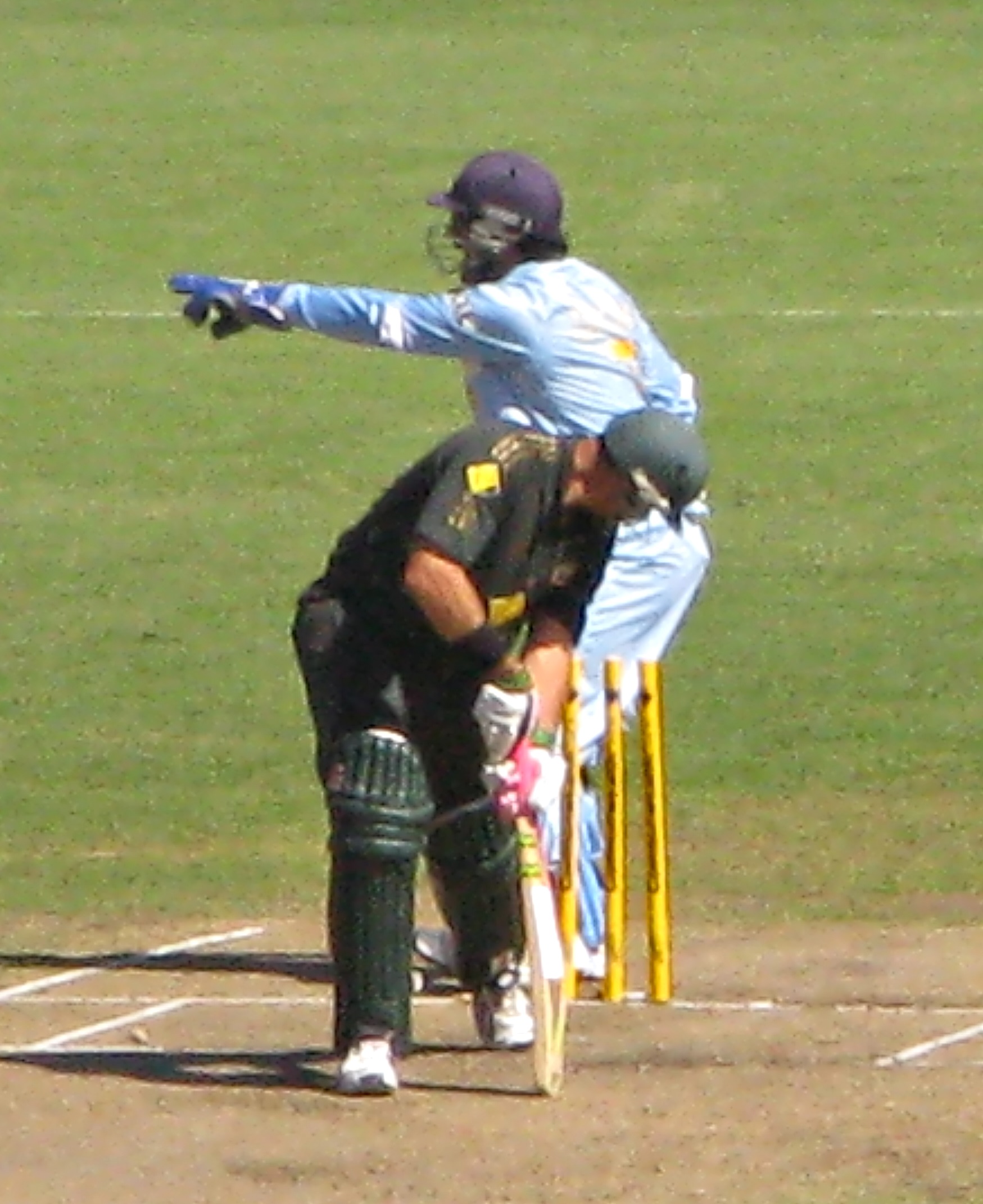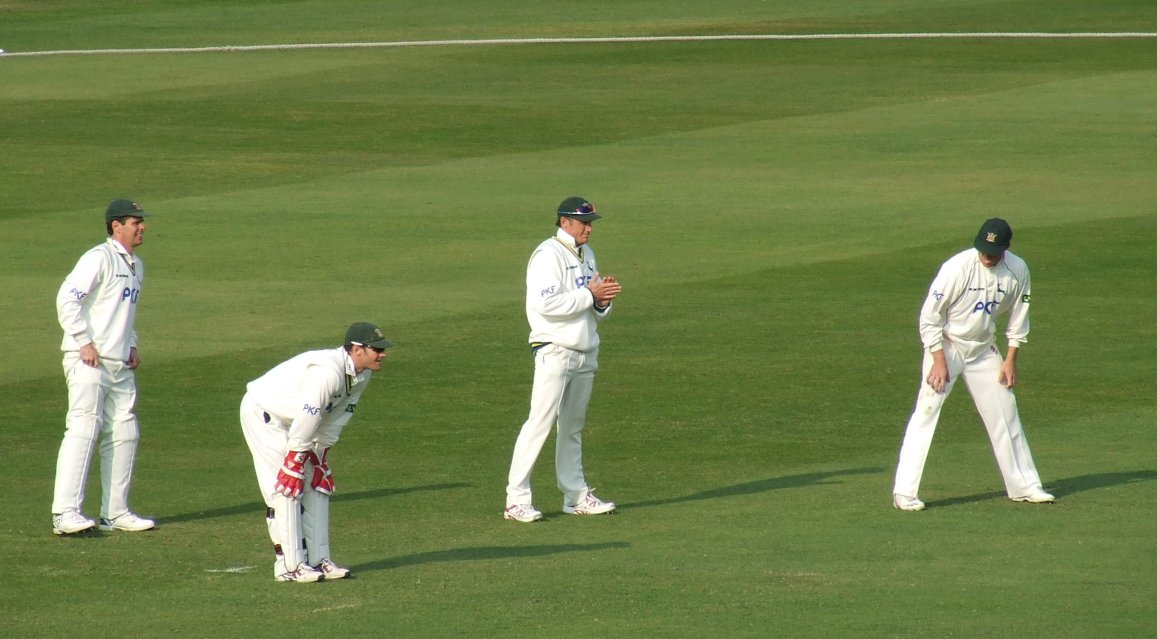|
List Of Canada Twenty20 International Cricketers
This is a list of Canadian Twenty20 International cricketers. A Twenty20 International (T20I) is an international cricket match between two teams that have official ODI status, as determined by the International Cricket Council. It is played under the rules of Twenty20 cricket and is the shortest form of the game. The first such match was played on 17 February 2005 between Australia and New Zealand. The Canada national cricket team played its first T20I match on 2 August 2008, against the Netherlands as part of the 2008 ICC World Twenty20 Qualifier, winning the match by 4 wickets. This list comprises all members of the Canada national cricket team who have played at least one T20I match. It is initially arranged in the order in which each player won his first Twenty20 cap. Where more than one player won his first Twenty20 cap in the same match, those players are listed alphabetically by surname. Key Players :''Statistics are correct as of 7 October 2023.'' See also *Twenty ... [...More Info...] [...Related Items...] OR: [Wikipedia] [Google] [Baidu] |
Twenty20 International
A Twenty20 International (T20I) is a form of cricket, played between two of the international members of the International Cricket Council (ICC), in which each team faces a maximum of twenty overs. The matches have top-class status and are the highest T20 standard. The game is played under the rules of Twenty20 cricket. Starting from the format's inception in 2005, T20I status only applied to Full Members and some Associate Member teams. However, in April 2018, the ICC announced that it would grant T20I status to all its 105 members from 1 January 2019. The shortened format was initially introduced to bolster crowds for the domestic game, and was not intended to be played internationally, but the first Twenty20 International took place on 17 February 2005 when Australia defeated New Zealand, and the first tournament was played two years later, with the introduction of the ICC T20 World Cup. In 2016, for the first time in a calendar year, more Twenty20 International matches (1 ... [...More Info...] [...Related Items...] OR: [Wikipedia] [Google] [Baidu] |
Batting Average (cricket)
In cricket, a player's batting average is the total number of runs they have scored divided by the number of times they have been out, usually given to two decimal places. Since the number of runs a player scores and how often they get out are primarily measures of their own playing ability, and largely independent of their teammates, batting average is a good metric for an individual player's skill as a batter (although the practice of drawing comparisons between players on this basis is not without criticism). The number is also simple to interpret intuitively. If all the batter's innings were completed (i.e. they were out every innings), this is the average number of runs they score per innings. If they did not complete all their innings (i.e. some innings they finished not out), this number is an estimate of the unknown average number of runs they score per innings. Each player normally has several batting averages, with a different figure calculated for each type of match ... [...More Info...] [...Related Items...] OR: [Wikipedia] [Google] [Baidu] |
Canada Twenty20 International Cricketers
Canada is a country in North America. Its ten provinces and three territories extend from the Atlantic Ocean to the Pacific Ocean and northward into the Arctic Ocean, covering over , making it the world's second-largest country by total area. Its southern and western border with the United States, stretching , is the world's longest binational land border. Canada's capital is Ottawa, and its three largest metropolitan areas are Toronto, Montreal, and Vancouver. Indigenous peoples have continuously inhabited what is now Canada for thousands of years. Beginning in the 16th century, British and French expeditions explored and later settled along the Atlantic coast. As a consequence of various armed conflicts, France ceded nearly all of its colonies in North America in 1763. In 1867, with the union of three British North American colonies through Confederation, Canada was formed as a federal dominion of four provinces. This began an accretion of provinces and territo ... [...More Info...] [...Related Items...] OR: [Wikipedia] [Google] [Baidu] |
List Of Canada ODI Cricketers
This is a list of Canadian One-day International cricketers. A One Day International, or an ODI, is an international cricket match between two representative teams, each having ODI status, as determined by the International Cricket Council (ICC). An ODI differs from Test matches in that the number of overs per team is limited, and that each team has only one innings. The list is arranged in the order in which each player won his first ODI cap. Where more than one player won his first ODI cap in the same match, those players are listed alphabetically by surname. Key Players :''Statistics are correct as of 12 February 2024.'' Notes See also *One Day International * Canadian cricket team * Canadian national cricket captains *List of Canada Twenty20 International cricketers References External linksHowstat {{DEFAULTSORT:List Of Canada Odi Cricketers < ... [...More Info...] [...Related Items...] OR: [Wikipedia] [Google] [Baidu] |
Canadian National Cricket Captains
This is a list of all cricketers who have captained Canada in an official international match. This includes the ICC Trophy, Under-19's games and One Day Internationals. The table is correct as of the 2007 Cricket World Cup. The current captain of Canadian national team is Saad Bin Zafar, he was appointed as the captain in October 2022. One Day Internationals Canada played their first ODI on June 9, 1979. Twenty20 Internationals Canada played their first Twenty20 Internationals on August 2, 2008. ICC Trophy Canada debuted in the ICC Trophy in the 1979 tournament Youth One-Day International captains This is a list of Canadian cricketers who have captained their country in an Under-19's ODI. External linksCricinfo [...More Info...] [...Related Items...] OR: [Wikipedia] [Google] [Baidu] |
Canadian Cricket Team
The Canada national cricket team represents Canada in international cricket. The team is organised by Cricket Canada, which became an Associate Member of the International Cricket Council (ICC) in 1968. With the United States, Canada was one of the two participants in the first ever international cricket match, played in New York City in 1844. The annual Canada–U.S. fixture is now known as the Auty Cup. Canada's first international match against a team other than the U.S. came in 1932, when Australia toured. As with the ICC associate members, the team's first major international tournament was the 1979 ICC Trophy in England, where they qualified for the 1979 World Cup after placing second to Sri Lanka. After that, Canada did not make another World Cup until 2003, although they remained one of the leading associate teams. From 2006 to 2013, Canada had both One Day International (ODI) and Twenty20 International status, making appearances at the 2007 and 2011 World Cups. ... [...More Info...] [...Related Items...] OR: [Wikipedia] [Google] [Baidu] |
Cap (sport)
In sport, a cap is a player's appearance in a game at international level. The term dates from the practice in the United Kingdom of awarding a cap to every player in an international match of rugby football and association football. In the early days of football, the concept of each team wearing a set of matching shirts had not been universally adopted, so each side would distinguish itself from the other by wearing a specific sort of cap. An early illustration of the first international football match between Scotland and England in 1872 shows the Scottish players wearing cowls, and the English wearing a variety of school caps. The practice was first approved on 10 May 1886 for association football after a proposal made by N. Lane Jackson , founder of the Corinthians: The act of awarding a cap is now international and is applied to other sports. Although in some sports physical caps may not now always be given (whether at all or for each appearance) the term ''cap'' for a ... [...More Info...] [...Related Items...] OR: [Wikipedia] [Google] [Baidu] |
Stumped
Stumped is a method of dismissing a batsman in cricket, which involves the wicket-keeper putting down the wicket while the batsman is out of his ground. (The batsman leaves his ground when he has moved down the pitch beyond the popping crease, usually in an attempt to hit the ball). The action of stumping can only be performed by a wicket-keeper, and can only occur from a legitimate delivery (i.e. not a no-ball), while the batsman is not attempting a run; it is a special case of a run out. Being "out of his ground" is defined as not having any part of the batsman's body or his bat touching the ground behind the crease – i.e., if his bat is slightly elevated from the floor despite being behind the crease, or if his foot is on the crease line itself but not completely across it and touching the ground behind it, then he would be considered out (if stumped). One of the fielding team (such as the wicket-keeper himself) must appeal for the wicket by asking the umpire. The appea ... [...More Info...] [...Related Items...] OR: [Wikipedia] [Google] [Baidu] |
Caught (cricket)
Caught is a method of dismissing a batsman in cricket. A batsman is out caught if the batsman hits the ball, from a legitimate delivery, with the bat, and the ball is caught by the bowler or a fielder before it hits the ground. If the ball hits the stumps after hitting the wicket-keeper, If the wicket-keeper fails to do this, the delivery is a "no ball", and the batsman cannot be stumped (nor run out, unless he attempts to run to the other wicket.) If the catch taken by the wicket-keeper,then informally it is known as caught behind or caught at the wicket. A catch by the bowler is known as caught and bowled. This has nothing to do with the dismissal bowled but is rather a shorthand for saying the catcher and bowler are the same player. (The scorecard annotation is usually ''c. and b.'' or ''c&b'' followed by the bowler's name.) Caught is the most common method of dismissal at higher levels of competition, accounting for 36,190 Test match dismissals between 1877 and 2012, wh ... [...More Info...] [...Related Items...] OR: [Wikipedia] [Google] [Baidu] |
Fielding (cricket)
Fielding in the sport of cricket is the action of fielders in collecting the ball after it is struck by the striking batter, to limit the number of runs that the striker scores and/or to get a batter out by either catching a hit ball before it bounces, or by running out either batter before they can complete the run they are currently attempting. There are a number of recognised fielding positions, and they can be categorised into the offside and leg side of the field. Fielding also involves preventing the ball from going to or over the edge of the field (which would result in runs being scored by the batting team in the form of a boundary). A ''fielder'' or ''fieldsman'' may field the ball with any part of his body. However, if while the ball is in play he wilfully fields it otherwise (e.g. by using his hat), the ball becomes dead and five penalty runs are awarded to the batting side, unless the ball previously struck a batter not attempting to hit or avoid the ball. ... [...More Info...] [...Related Items...] OR: [Wikipedia] [Google] [Baidu] |
Bowling Average
In cricket, a player's bowling average is the number of runs they have conceded per wicket taken. The lower the bowling average is, the better the bowler is performing. It is one of a number of statistics used to compare bowlers, commonly used alongside the economy rate and the strike rate to judge the overall performance of a bowler. When a bowler has taken only a small number of wickets, their bowling average can be artificially high or low, and unstable, with further wickets taken or runs conceded resulting in large changes to their bowling average. Due to this, qualification restrictions are generally applied when determining which players have the best bowling averages. After applying these criteria, George Lohmann holds the record for the lowest average in Test cricket, having claimed 112 wickets at an average of 10.75 runs per wicket. Calculation A cricketer's bowling average is calculated by dividing the numbers of runs they have conceded by the number of wickets t ... [...More Info...] [...Related Items...] OR: [Wikipedia] [Google] [Baidu] |
Wicket
In cricket, the term wicket has several meanings: * It is one of the two sets of three stumps and two bails at either end of the pitch. The fielding team's players can hit the wicket with the ball in a number of ways to get a batsman out. ** The wicket is guarded by a batsman who, with his bat (and sometimes with his pads, but see the laws on LBW, leg before wicket), attempts to prevent the ball from hitting the wicket (if it does, he is bowled out) and to score runs where possible. * Through metonymic usage, the dismissal of a batsman is known as the ''taking of a wicket'', * The cricket pitch itself is sometimes referred to as ''the wicket''. History The origin of the word is from wicket gate, a small gate. Originally, cricket wickets had only two stumps and one bail and looked like a gate, much like the wicket used in the North American game of wicket. The third (middle) stump was introduced in 1775, after Lumpy Stevens bowled three successive deliveries to John ... [...More Info...] [...Related Items...] OR: [Wikipedia] [Google] [Baidu] |







